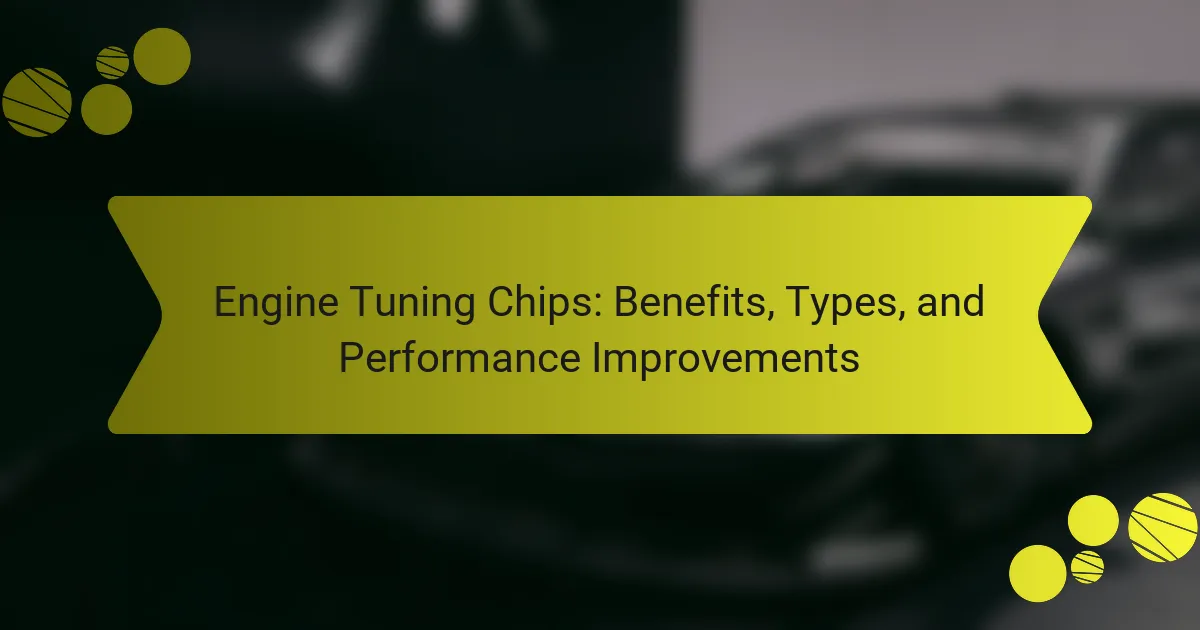Engine tuning chips can significantly enhance your vehicle’s performance, offering benefits like increased horsepower and improved fuel efficiency. This article explores the various types of tuning chips, their specific performance improvements, and potential impacts on engine reliability. Additionally, we will discuss advanced features and modifications that can optimize your driving experience. Understanding these elements will help you make informed decisions about engine tuning options.

What benefits do engine tuning chips provide?
Engine tuning chips enhance vehicle performance by optimizing engine parameters for increased power, fuel efficiency, and responsiveness. These chips adjust air-fuel ratios, ignition timing, and boost levels, leading to noticeable improvements in acceleration and overall driving experience. Common benefits include up to 30% more horsepower, better throttle response, and improved fuel economy. Additionally, tuning chips can be tailored for specific driving conditions, making them versatile for various applications.
How do tuning chips enhance fuel efficiency?
Tuning chips enhance fuel efficiency by optimizing engine performance and adjusting fuel-air mixtures. These chips modify engine parameters, leading to better combustion and reduced fuel consumption. As a result, vehicles can achieve improved mileage and lower emissions. Enhanced throttle response and power output are additional benefits, making tuning chips a valuable investment for efficiency-focused drivers.
What performance gains can be expected from tuning chips?
Tuning chips can deliver significant performance gains, including increased horsepower, improved torque, and enhanced throttle response. These chips optimize engine parameters, allowing for better fuel efficiency and overall driving experience. Users can expect gains of 10-30% in power, depending on the vehicle and chip type.
Which vehicle types benefit most from tuning chips?
Diesel and performance vehicles benefit most from tuning chips. Diesel engines gain improved torque and fuel efficiency, while performance cars experience enhanced horsepower and throttle response. These chips optimize engine parameters, leading to significant performance upgrades. Additionally, trucks and SUVs often see better towing capacity and overall power.

What types of engine tuning chips are available?
There are several types of engine tuning chips available, each designed for specific performance enhancements. Common types include performance chips, economy chips, and racing chips. Performance chips boost horsepower and torque, economy chips enhance fuel efficiency, and racing chips optimize engine performance for competitive settings. Each type varies in its tuning capabilities and intended use.
How do plug-and-play chips differ from custom chips?
Plug-and-play chips are pre-configured for easy installation, while custom chips are tailored to specific vehicle needs. Plug-and-play options offer convenience and faster setup, but custom chips provide optimized performance and unique tuning capabilities. The choice depends on user preferences for simplicity versus performance.
What are the advantages of OBD-II tuning chips?
OBD-II tuning chips offer several advantages, including enhanced engine performance, improved fuel efficiency, and customizable tuning options. These chips optimize engine parameters, leading to increased horsepower and torque. Additionally, they can provide real-time diagnostics, allowing users to monitor vehicle performance effectively. The ability to adjust settings for different driving conditions is a unique attribute that enhances user experience. Overall, OBD-II tuning chips significantly improve vehicle performance and efficiency.
Which brands are leading in engine tuning chip technology?
Leading brands in engine tuning chip technology include APR, Cobb Tuning, RaceChip, and Bully Dog. These companies excel in enhancing vehicle performance through advanced chip tuning solutions. APR is known for its high-performance ECU upgrades, while Cobb Tuning focuses on user-friendly access to tuning options. RaceChip offers versatile tuning solutions for various vehicle models, and Bully Dog specializes in diesel performance tuning. Each brand brings unique attributes, such as custom tuning options and extensive vehicle compatibility, which set them apart in the market.

How do engine tuning chips impact vehicle reliability?
Engine tuning chips can enhance vehicle performance but may affect reliability negatively. These chips optimize fuel efficiency and power output, which can lead to increased stress on engine components. Over time, this stress may result in premature wear or failure. Regular monitoring and maintenance can mitigate these risks.
What potential risks should users be aware of?
Engine tuning chips can pose risks such as engine damage, voided warranties, and increased emissions. Users should be cautious about compatibility with their vehicle. Improper installation may lead to performance issues or malfunction. Additionally, tuning chips can affect fuel efficiency, sometimes resulting in higher consumption.
How can tuning chips affect warranty status?
Using tuning chips can void your vehicle’s warranty. Manufacturers often consider modifications as alterations that may lead to performance issues. This can result in denial of warranty claims related to engine or transmission problems. Always check specific warranty terms before installing tuning chips.

What unique features do advanced tuning chips offer?
Advanced tuning chips offer features like real-time data monitoring, customizable tuning profiles, and enhanced fuel efficiency. These chips often include unique algorithms for optimizing performance based on driving conditions. Additionally, some advanced chips provide rare attributes such as integration with smartphone apps for user-friendly adjustments. Their ability to adapt to various engine types further distinguishes them in the market.
How does real-time data monitoring enhance performance?
Real-time data monitoring significantly enhances performance by providing immediate feedback on engine parameters. This allows for timely adjustments, optimizing fuel efficiency and power output. Enhanced data accuracy leads to better tuning strategies, which can result in improved overall vehicle performance. For instance, monitoring air-fuel ratios in real time enables precise tuning, maximizing engine responsiveness and minimizing emissions.
What customization options are available with premium chips?
Premium chips offer various customization options, including performance tuning, fuel maps, and throttle response adjustments. Users can select specific parameters to optimize engine performance for their driving style. Advanced models may include features like real-time monitoring and data logging. Customization enhances the overall driving experience, allowing for tailored performance improvements.

Which tuning chip modifications are less common but noteworthy?
Less common but noteworthy tuning chip modifications include custom firmware, advanced fuel mapping, and integration with aftermarket sensors. These modifications can enhance engine performance by optimizing air-fuel ratios and adjusting ignition timing. Custom firmware allows for tailored performance adjustments, while advanced fuel mapping fine-tunes engine efficiency. Integration with aftermarket sensors provides real-time data for improved tuning accuracy.
How do tuning chips vary by engine type?
Tuning chips vary significantly by engine type due to differences in performance characteristics and tuning requirements. Gasoline engines typically benefit from chips that enhance throttle response and fuel efficiency, while diesel engines often require chips that improve torque and towing capacity. Additionally, turbocharged engines may utilize tuning chips to optimize boost levels and air-fuel ratios, further enhancing performance. Each engine type necessitates specific tuning strategies to achieve optimal results, reflecting unique attributes like fuel type and intended use.
What are the rare features that some chips provide?
Some chips offer rare features such as advanced data logging, customizable tuning maps, real-time monitoring, and compatibility with multiple vehicle models. These attributes enhance performance and provide unique user experiences.

How can users optimize their experience with tuning chips?
Users can optimize their experience with tuning chips by selecting the right type, understanding installation, and adjusting settings. Choosing the appropriate tuning chip enhances engine performance and fuel efficiency. Proper installation ensures compatibility and maximizes benefits. Regularly adjusting chip settings based on driving conditions can lead to improved performance and responsiveness.
What best practices should be followed during installation?
To ensure optimal performance and safety during installation, follow these best practices. First, read the manufacturer’s instructions thoroughly. Second, verify compatibility with your vehicle’s make and model. Third, disconnect the battery to prevent electrical shorts. Fourth, use appropriate tools to avoid damaging components. Finally, check all connections and settings before reassembling and reconnecting the battery. These steps enhance the effectiveness of engine tuning chips and minimize potential issues.
Which common mistakes should be avoided when using tuning chips?
Avoiding common mistakes with tuning chips enhances performance and longevity. Key mistakes include neglecting to verify compatibility, failing to follow installation instructions, ignoring the need for supporting modifications, and not monitoring engine parameters post-installation. These oversights can lead to suboptimal results or damage.
How can users monitor and evaluate performance improvements post-installation?
Users can monitor and evaluate performance improvements post-installation by utilizing diagnostic tools and performance metrics. These tools provide real-time data on engine performance, fuel efficiency, and response times. Users should compare pre- and post-installation metrics to assess improvements effectively. Key performance indicators include horsepower gains, torque increases, and fuel consumption reductions. Regular monitoring ensures that any adjustments needed can be made for optimal performance.



